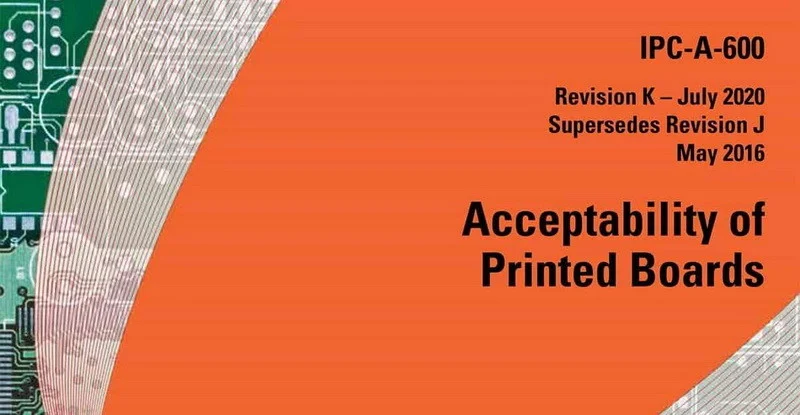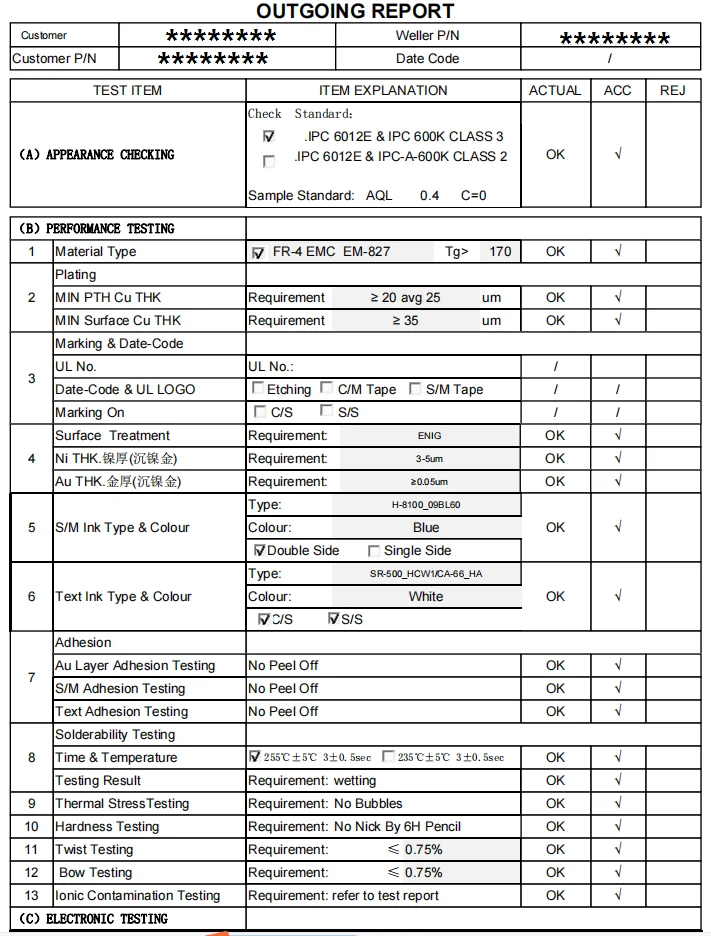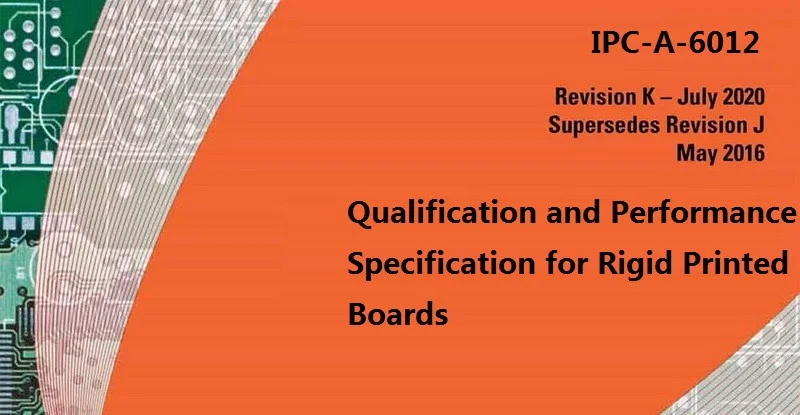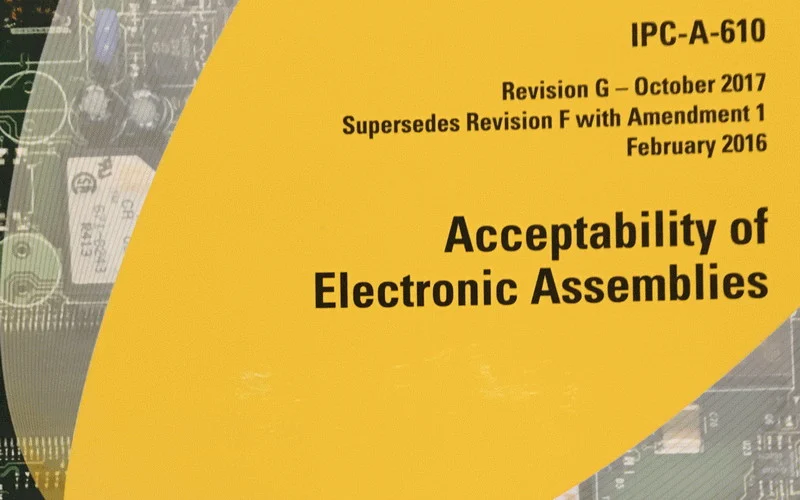
The Difference between IPC-6012, IPC-A-600, and IPC-A-610
Specifically, both specifications of the IPC-A-6012 and the IPC-A-600 are guiding documents made for the bare printed circuit boards.
IPC-A-600: is a specification and guiding document for the inspection criteria of PCB, which is a the visual representation of the IPC-A-6012 document.
IPC-A-6012: is a guiding document for the rigid PCB manufacturing process.
IPC-A-610: is a guiding document for the acceptability of electronics assemblies, is the most widely used as inspection criteria in the electronics industry and has acquire an international reputation as the source for end-product acceptance standard for consumer and high reliability printed circuit board assemblies.
IPC-A-600: Acceptability of Printed Circuit Boards

IPC-A-600 is the specification document for the inspection of the final PCB board. So, when a printed circuit board is finished it’s manufacturing process, it should be inspected according to the criteria of IPC-A-600 (class 1,2,3) before it is delivered to a customer. By doing this process, it is inspected and measured whether the final PCB’s features (such as final PCB thickness, copper weight, soldering-ability, hole size, control impedance value,etc) meets the requirements, whether there are no errors or any flaws in it that cannot be contained in it, most of physical features are inspected on this work. The limitation of the specification IPC-A-600 is that it is designed purely for the purpose of inspection.
The advantage of this specification compared to IPC-A-6012 is that it include a lot of referred photos. So, basically every aspect that is assessed is illustrated clear with a photo, what aspect you should pay attention to, and what it exactly looks like in practice. This is a good tool for an inspector who can still do the inspection work even if he does not have much knowledge and experience with printed circuit boards.

Normally, the PCB manufacturer should issue a set of outgoing report (QA report) for this inspection for the customer’s reference.
IPC-A-6012: Qualification and Performance Specification for Rigid Printed Circuit Boards Manufacturing Process

But, the IPC-A-6012 is the qualification and the performance specification for rigid printed circuit boards and this is more about the PCB manufacturing processes. Which basically builds on document IPC-A-6011. IPC-A-6011 is a general performance requirement and the IPC-A-6012 is the more comprehensive specification for rigid printed circuit boards. In practice, these are also named as FR-4 printed circuit boards. As it is a performance requirement, it is also specified what the circuit board manufacturer should deliver in principle. It is also specified that which kind of raw materials should be used for PCB fabrication, which type of test must be carried out and the frequency of that test, depending entirely on the type of electronic device that will be built with it later and what application that printed circuit board will be used on. Whether that is a consumer electronic product or something else that is used in the aircraft industry such as high Tg PCB, military application such as High Frequency PCB,aerospace & defense field such as RF & Microwave PCB, for example. As a result, the number and type of tests to be done are different and this is all specifically described in IPC-A-6012. Next, the requirements that are set for thicknesses of the so-called finishes are described (the end surfaces finishing that are put on the copper tracks to protect them against oxidation).
The values and detail requirements for this are also stated in this document, as well as the inspection criteria that can be found in the IPC-A-600. The requirements in one document mostly are the same as the requirements in the other document. The obvious difference is that the IPC-A-6012 does not contain many referred drawings and photos,but IPC-A-600 have. Most references is made to the IPC-A-600 for photos, so you should actually use them side by side. The design of the entire production and manufacturing process of printed circuit boards upon the IPC-A-6012 design and the inspection criteria according to IPC-A-600. Then you actually have used both specific documents correctly as they are intended and you have provided both your production and your inspection department with the documents that they need
IPC-A-610: Acceptability of Electronics Assemblies
IPC-A-610 is the most widely used electronics assembly criteria in the electronics world. This is a must for all quality assurance and assembly departments. The latest version IPC-A-610E specifically illustrates industry-accepted workmanship standard for electronics assemblies through full-color photographs and illustrations.

The document include hardware installation, soldering criteria, including lead free connections,soldered requirements for connecting to terminals,surface mounting criteria for chip components, leadless and leaded chip carriers, swaged hardware and heat-sink requirements of mechanical assemblies,component mounting criteria for DIPS, socket pins and card edge connectors,jumper wire assembly requirements,solder fillet dimensional criteria for all major SMT component groups,soldering, such as tomb-stoning, de-wetting, voiding and others.
So, IPC-A-610 is a comprehensive criteria for printed circuit board assemblies throughout the medical, aerospace, and military manufacturing industry.
So,IPC-A-610 is a comprehensive criteria for printed circuit board assemblies throughout the medical, aerospace, and military manufacturing industry. It’s standard is comprised of three classes that are distinguished by certain principles and qualities.
Class 1
It is the lowest class in electronics assembly, the most lenient with potential defects. Electronic products in this class are typically used in cheap, low-consequence features such children’s toys. Though expected to function as expected, they also have a shorter lifespan. As such, products utilizing class 1 electronics assemblies are priced reasonably to justify the quality.
Class 2
This is a common class of IPC standards with it’s typically the most requested for non-critical electronic assemblies because end-products may not be the highest quality demand but are sure to have longer and more effective reliability. Much like the first class, this one also allows for some degree of imperfections, such as “deviate pad” component placement that will still function appropriately but fail to look perfect.
Class 3
As the highest standard in electronics assemblies field, class 3 requires the best workmanship in terms of quality, durability, reliability and neatness. Due to the stringent requirements that are in place, class 3 is typically required for many high-end electronic products and other critical assemblies,such as military product assembly,medical assembly, aerospace electronics assembly, etc,. Obviously, the highest quality assemblies come at a premium. Perfect component placement and soldering cosmetic will require longer build time and additional cost accordingly.
Reminding: If you need IPC class 3 for your electronic products and separately subcontract the PCB fabrication and PCB assembly to different manufacturers, do not forget to specify both of them that IPC class 3 is necessary, so that they can perform the same criteria at it’s own field to avoid any misunderstanding.




